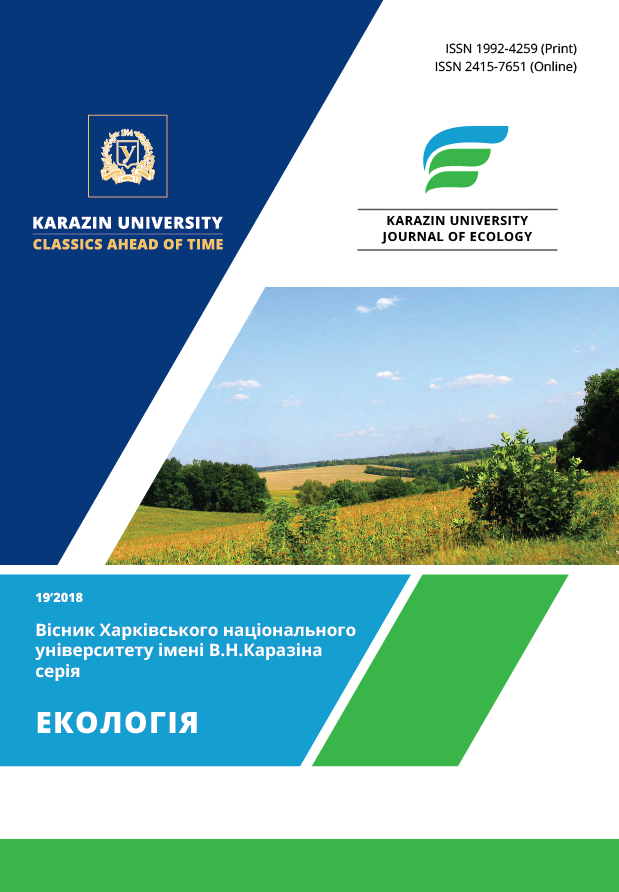Analysis of Technogenic Loading on the Air Basins of Individual Industrial and Municipal Aglomerations of Eastern Ukraine (Using Dnipro City as an Example)
Abstract
Purpose. Estimation of atmospheric air pollution level in the Dnipro city in modern conditions and technogenic loading on the air basin of the Dnipropetrovsk region. Methods. Statistical. Results. Volumes of pollutant emissions from stationary sources are 4 times more than emissions from mobile sources. The maximum values of emissions of pollutants are noted for the enterprises of the processing and extractive industry. The estimation of the level of air pollution in Dnipro city was carried out. An increase in the level of contamination in Dnipro city was indicated during the study period. Substances for which the quality of atmospheric air constantly does not meet the standards include dust, nitrogen dioxide and formaldehyde. The level of atmospheric air pollution can be classified as «polluted» and «highly polluted». The module of technogenic loading on the air basin of the Dnipropetrovsk region and Dnipro city was calculated. The rate of the technogenic loading in Dnipropetrovsk region from stationary sources considerably exceeds the mobile ones. In Dnipro city, the level of technogenic loading from stationary sources is an order of magnitude higher than the corresponding in the region. This indicates a significant level of technogenic loading on the Dnipro city air basin exactly from stationary sources. The volume of pollutant emissions from stationary sources in the region is an order of magnitude higher compared to the same in Dnipro city and the area of the region is two orders of magnitude larger. The reduction of the level of technogenic loading on the air basin of Dnipropetrovsk region as a whole was noted. Conclusion. Dnipropetrovsk region belongs to regions with significant industrial potential. The primary tasks for the improvement of the air basin are the development of measures to reduce emissions from stationary sources, as well as optimization of the monitoring system in order to determine the list of priority pollutants.
Downloads
References
Rehionalna dopovid pro stan navkolyshnoho pryrodnoho seredovyshcha v Dnipropetrovskii oblasti za 2016 rik.(2017).[ Regional report on the state of the environment in Dnipropetrovsk region for 2016]. Dnipro, 246 [In Ukrainian].
Natsionalna dopovid pro stan navkolyshnoho pryrodnoho seredovyshcha v Ukraini u 2015 rotsi. (2017). [National report on the state of the environment in Ukraine in 2015]. Kyiv, 308 [In Ukrainian].
Tymoshenko, L.V. (2013).Upravlinnia rivnem zabrudnennia atmosfernoho povitria peresuvnymy dzherelamy u promyslovomu misti [Management of the air pollution level by mobile sources in an industrial city]. Ekonomichnyi visnyk, 3, 121 – 129 [In Ukrainian].
Levchuk, K.O., Volosova Ye.R. (2015). Ekolohichni problemy Dnipropetrovshchyny [Ecological problems of the Dnipropetrovsk region]. Naukovi pratsi. Ser. «Tekhnohenna bezpeka. Radiobiolohiia», 261 (249), 161 – 166 [In Ukrainian].
Polishchuk, S.Z., Demydenko, A.S., Balychev, I.I., Kovalenko, Ye.O. (2015). Analiz vplyvu statsionarnykh ta peresuvnykh dzherel zabrudnennia na stan atmosfernoho povitria m. Dnipropetrovska [Analysis of the influence of stationary and mobile sources of pollution on the state of atmospheric air in the city of Dnipropetrovsk]. Stroytelstvo, materyalovedenye, mashynostroenye, 84, 167 – 171 [In Ukrainian].
Krynychna, I.P., Kostenko, V.O. (2017). Priorytety rehionalnoi polityky u sferi ekolohichnoi bezpeky Ukrainy (na prykladi Dnipropetrovskoi oblasti) [Priorities of regional policy in the field of environmental safety of Ukraine (for example, Dnipropetrovsk region)]. Derzhavne budivnytstvo, 1. Available at: http://www.kbuapa.kharkov.ua/e-book/db/2017-1/doc/2/01.pdf (data zvernennia: 17.11.2018 r.). [In Ukrainian].
Biliaiev, M.M., Rusakova, T.I. (2018). Kompiuterna otsinka rivnia zabrudnennia atmosfernoho povitria pid diieiu tekhnohennykh dzherel [Computer estimation of the level of pollution of atmospheric air under the influence of technogenic sources]. Zbirnyk naukovykh prats NSU, 54, 337 – 344 [In Ukrainian].
Kaspiitseva,V.Iu. (2017). Otsinka i prohnoz yakosti atmosfernoho povitria na rehionalnomu rivni [ Assess-ment and forecast of the quality of atmospheric air at the regional level ]. Kiev National University of Civil Engineering and Architecture. Kyiv. 24 [In Ukrainian].
Polonska, A.Ie., Prystavka, P.O. (2007). Model tekhnohennoho vplyvu na povitriane seredovyshche za vykorystanniam HIS «AirNorm» [Model of technogenic influence on the air environment using GIS «Air-Norm» ]. Matematychne modeliuvannia, 1 (16). 83 – 85 [In Ukrainian].
Ekolohichnyi pasport Dnipropetrovskoi oblasti za 2013 rik. (2014). [Ecological passport of Dnipropetrovsk region for 2013]. Dnipro, 138 [In Ukrainian].
Ekolohichnyi pasport Dnipropetrovskoi oblasti za 2014 rik. (2015). [Ecological passport of Dnipropetrovsk region for 2014]. Dnipro, 229 [In Ukrainian].
Ekolohichnyi pasport Dnipropetrovskoi oblasti za 2015 rik. (2016). [Ecological passport of Dnipropetrovsk region for 2015]. Dnipro, 229 [In Ukrainian].
Ekolohichnyi pasport Dnipropetrovskoi oblasti za 2017 rik. (2018). [Ecological passport of Dnipropetrovsk region for 2017]. Dnipro, 287. Available at: https://www.slideshare.net/DIA_investment/ss-87975316 [In Ukrainian].
Bezuhlaia, E. Iu.(1989). Monytorynh sostoianyia zahriaznenyia atmosfery v horodakh [ Monitoring the state of atmospheric pollution in cities]. Lenynhrad: Hydrometeoyzdat, 116 [In Russian].
Adamenko, O.M., Rudko, H.I. (1998). Ekolohichna heolohiia [Ecological geology]. Kyiv: Manuskrypt. 348. [In Ukrainian].
Elektronnyi resurs: Available at: http://old.adm.dp.gov.ua/OBLADM/obldp.nsf/index.pdf
Authors who publish with this journal agree to the following terms:
- Authors retain copyright and grant the journal right of first publication of this work under the terms of a license Creative Commons Attribution License 4.0 International (CC BY 4.0).
- Authors are able to enter into separate, additional contractual arrangements for the non-exclusive distribution of the journal's published version of the work (e.g., post it to an institutional repository or publish it in a book), with an acknowledgement of its initial publication in this journal.
- Authors are permitted and encouraged to post their work online (e.g., in institutional repositories or on their website) prior to and during the submission process, as it can lead to productive exchanges, as well as earlier and greater citation of published work.





